EVALUATION OF BIOTIC AND ABIOTIC FACTORS IN SOUTH PLAZA ISLAND
Evaluation of biotic and abiotic factors that affect the restoration of Opuntia echios var. echios in South Plaza Island
Despite being one of the smallest islands in the archipelago, South Plaza has become a known tourist destination due to its extraordinary flora and fauna. The Galapagos hawk (Buteo galapagoensis), the land iguana (Conolophus subcristatus) and the cactus Opuntia echios var. echios form a very important trophic chain for the island's ecosystem (Christian & Tracy, 1980; de Vries, 1989) . However, Opuntia echios var. echios has been classified by the International Union for Conservation of Nature (IUCN) as a threatened species due to: its slow growth (around 40 cm in 5 years) (Campbell et al. , 2012; Snell et al., 1994); the effect of biotic and abiotic factors such as the El Niño and La Niña phenomena, characterized by torrential rains and waves of cold and heat; the introduction of rodents (Mus musculus); and herbivory by land iguanas, which devour fruits and cladodes of reproductive-age individuals at a rate that prevents their natural regeneration (Jaramillo et al., 2017; Sulloway & Noonan, 2015). Also, another understudied factor is the soil properties and their effect on the Opuntia population.
Currently, the project is focused on contributing to the restoration of the ecological integrity of South Plaza Island through the recovery of Opuntia echios var. echios populations, keystone species, and ecosystem engineers, as they can modulate the environment by changing its composition. This allows new niches to be generated that can be occupied by other species. The goal is to achieve a stable and healthy population, using the as a reference ecosystem from Plaza Norte island, which is in good condition.
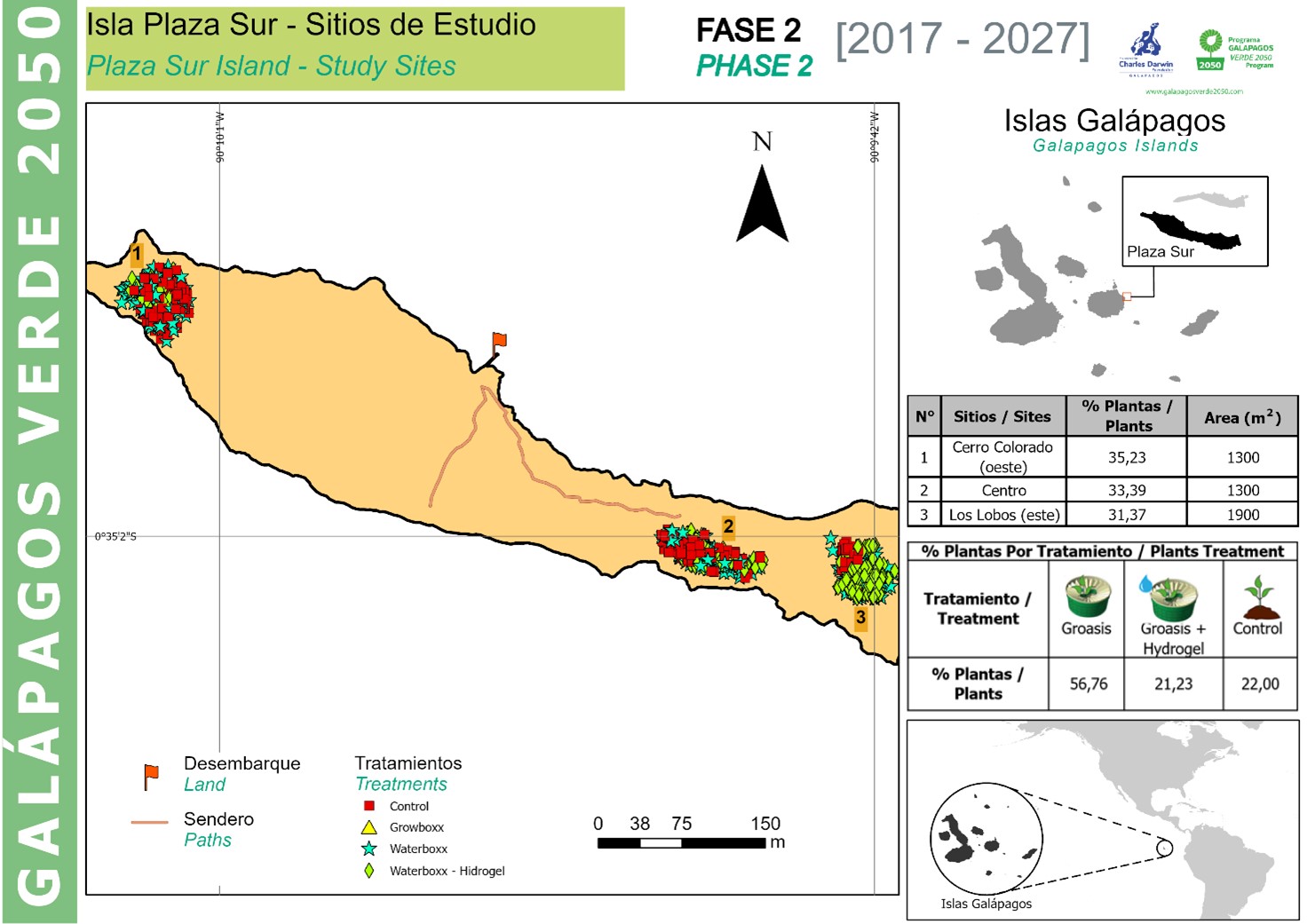
Geographical location of the three study sites and Opuntia echios var. echios seedlings in South Plaza Island. Produced by: GV2050 team 2022
Timeline
The GV2050 was born in 2013 as a single project with two components: ecological restoration and sustainable agriculture, remaining so until 2021 and after taking the category of Program made up of 7 different projects. On Plaza Sur Island, it began in 2015, during this time, various experiments were carried out in three different study sites that are currently active, planting new specimens each year. We will continue to recover this island until 2050.
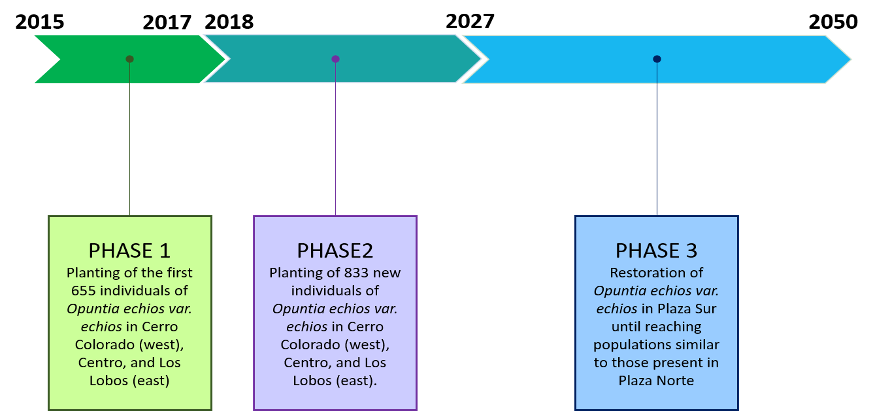
The phases of the Ecological Restoration project in South Plaza.
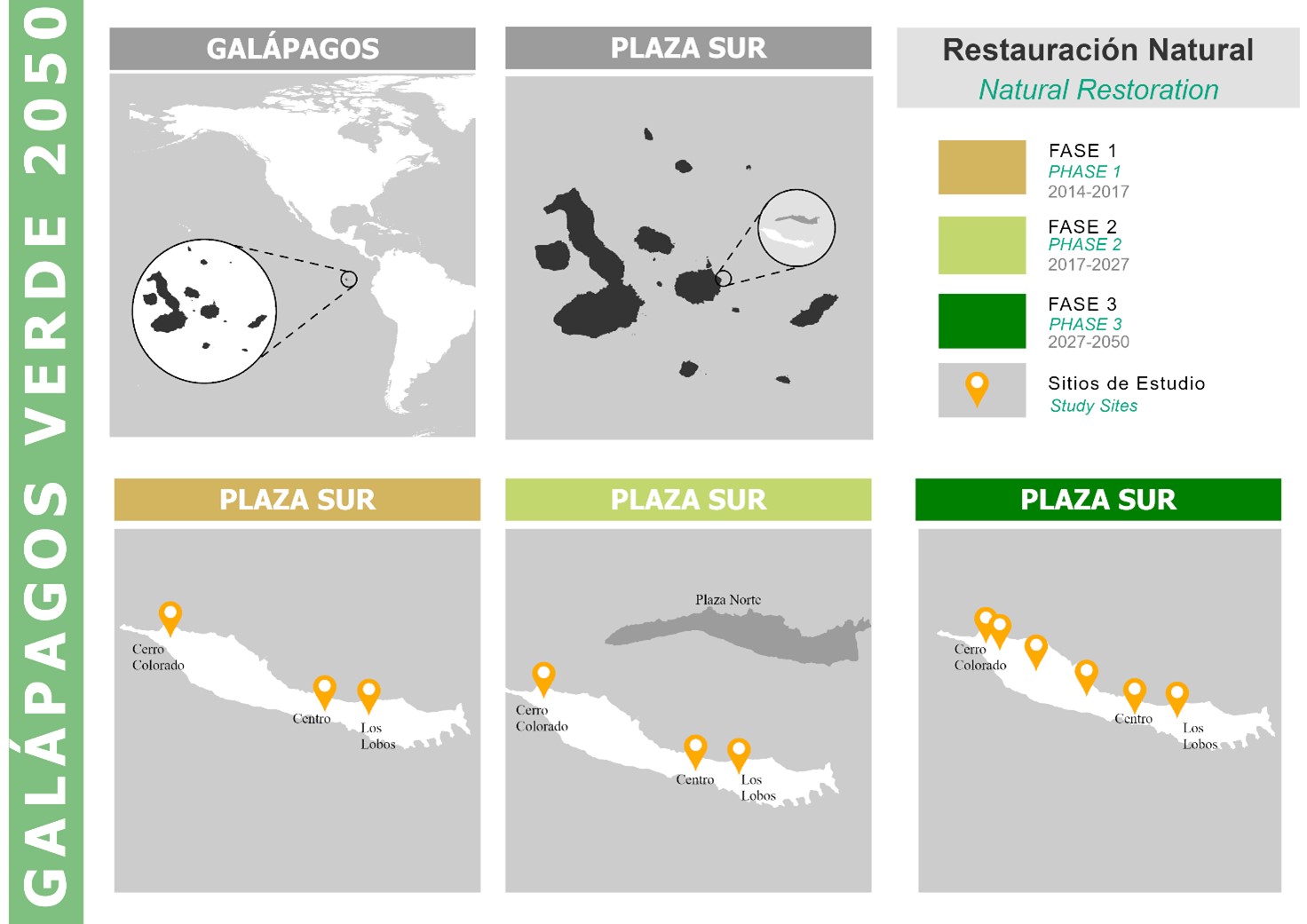
Map of the phases of the Ecological Restoration project in South Plaza. Prepared by: GV2050 team 2022
Obtaided Results
In the last century, the population Opuntia echios var. echios decreased by at least 60% in South Plaza. In 2014, 426 cacti were counted with a regeneration rate of zero (Jaramillo et al., 2017; Sulloway & Noonan, 2015), and in 2015 only 55 specimens were counted. After 2018, the population increased by 106% from the last recorded population estimates of 426 in 2014 (Jaramillo et al., 2017; Tapia et al., 2019), and it has continued to increase, reaching 535 individuals in 2021.
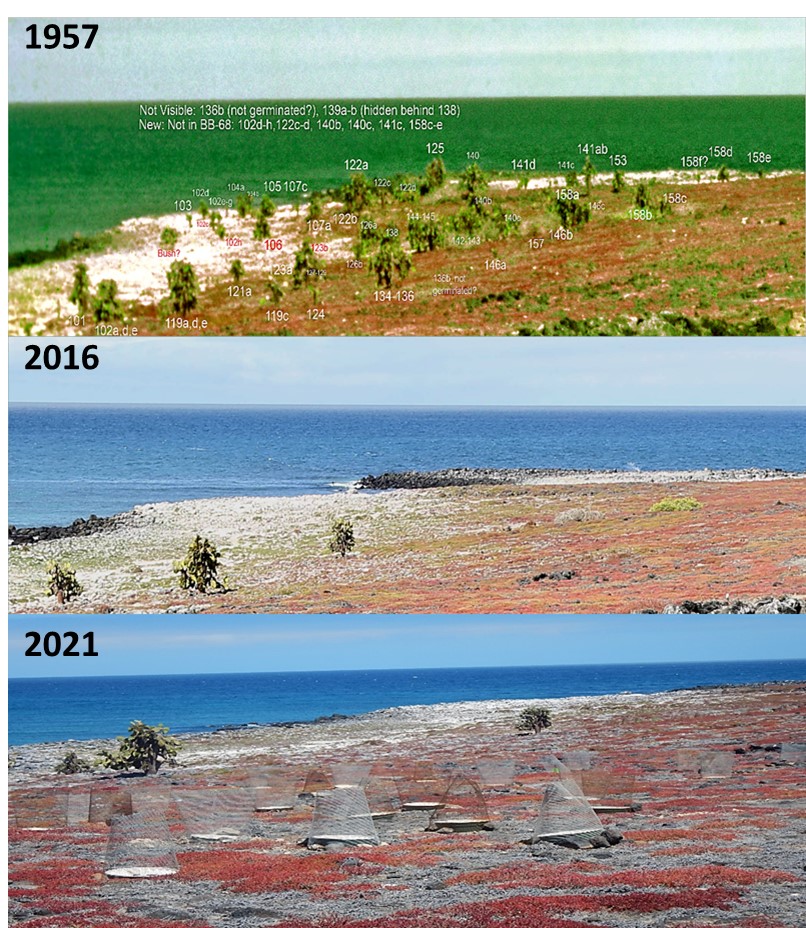
Photographic records of the change in the population of Opuntia echios var. echios in the Los Lobos (East) site on South Plaza Island. The photographs include records from 1957 (provided by Robert Bowman), 2016 (when the Galapagos Verde 2050 project began the first phase of restoration) and 2021 (Second Phase of restoration of cacti with WST).
The work of the GV2050 with Opuntia echios var. echios in South Plaza is very similar to that carried out with Opuntia megasperma var. orientalis in Española, since planting is based on seeds obtained from fruits and droppings of land iguanas (Conolophus subcristatus) and cladodes. That is, vegetative or clonal reproductions are being carried out with the sowing of cladodes, and also reproductions with genetic variation by sowing seeds (Jaramillo et al ., 2020). Added to this is the planting of strengthened seedlings cultivated in two different places: a group has been germinated in the laboratory of the Charles Darwin Foundation and another group has been cultivated in the "Hernán Carrión" nursery of the Directorate of the Galapagos National Park; when the seedlings are about two years old, they are suitable for repatriation. It is important that different cultivation methodologies are used, since each one has its benefits. For example, planting cladodes ensures rapid growth, but does not provide genetic variability, which means that the gene pool of the population is reduced and may weaken. On the contrary, the sowing of seeds ensures genetic variability, which enriches the population, but does not ensure the germination and survival of all the seeds. Following this methodology, 1488 individuals have been planted in the three study sites: West Cerro Colorado, Centro and Los Lobos Este. Of course, the planting included the installation of WST (Waterboxx® and Hydrogel, or their combination) to study its effectiveness.
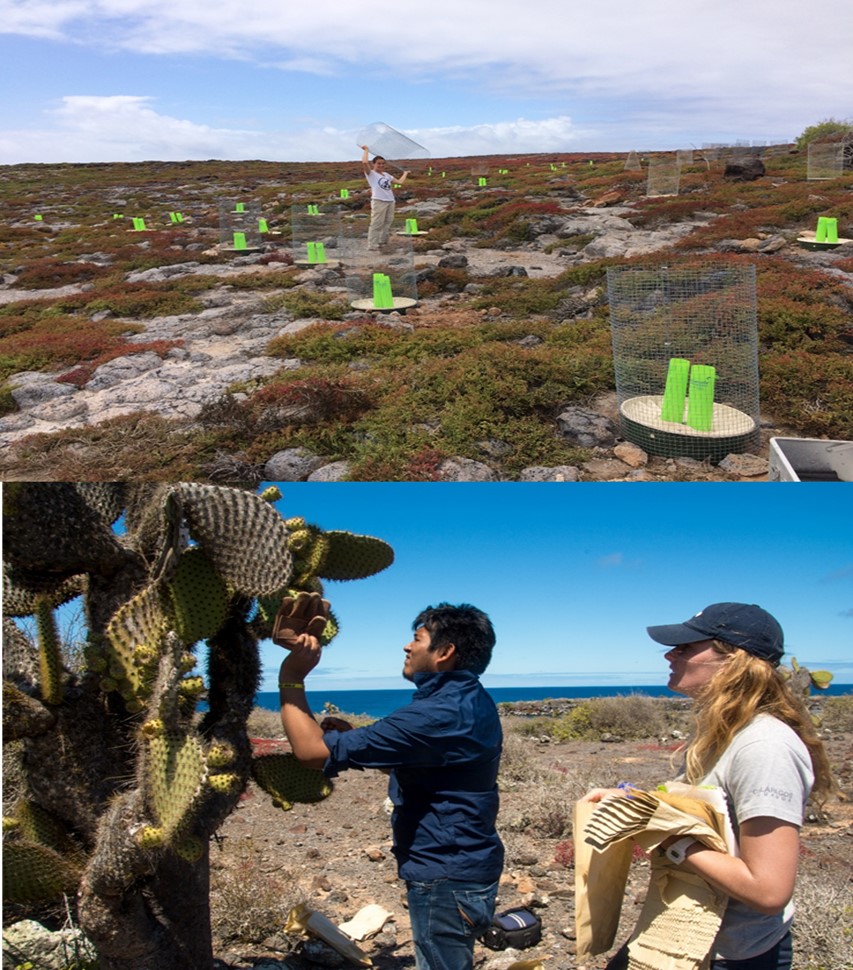
GV2050 team planting Opuntia echios var. echios individuals with Groasis technology Waterboxx ® and protective fences (above) and harvesting of cladodes for subsequent planting (below).
.
Can you imagine how many plants we have planted in South Plaza?
Since 2015, when the project began working in South Plaza, until 2021, we have planted a total of 1,036 Opuntia echios individuals. var . echios , of which 605 have survived.
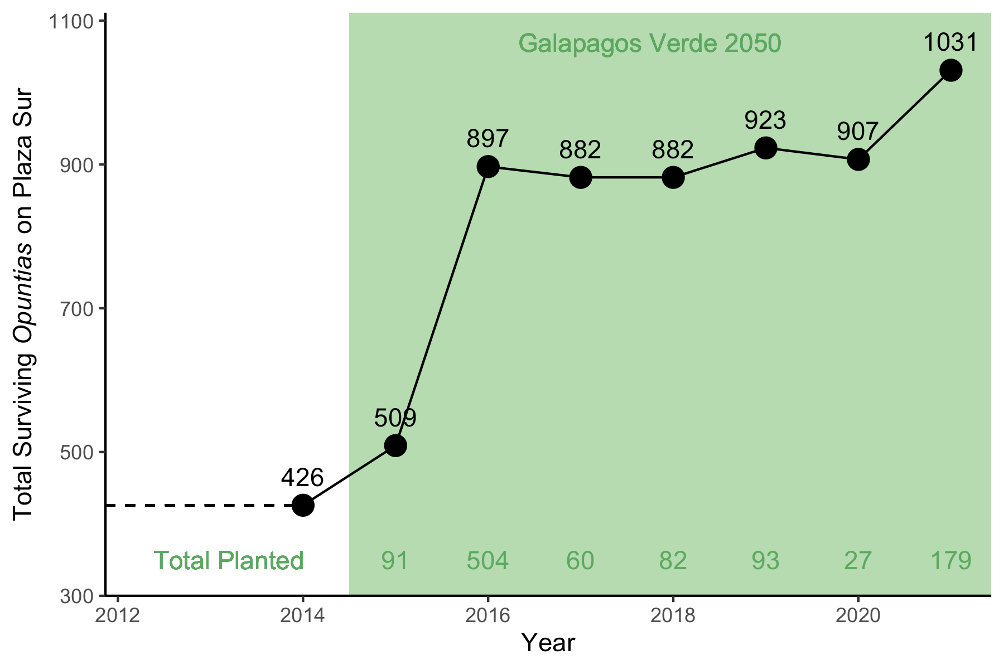
Representative graph of all O. echios planted in Plaza Sur by GV2050 from 2014 to 2021.
.
Regarding the treatments with water-saving technologies, in the lower graph, it can be seen that Waterboxx ® had the greatest success on Opuntia echios var. echios, since it is the one with the highest percentage of survival (50%) in the longest time (72 months). It is followed by planting with Waterboxx ® + Hydrogel, since in month 48 it presents a 45% survival, approximately; and, finally, there would be the treatment with only Hydrogel, since it is the one with the lowest survival rate in the shortest time: at month 38 they have approximately 40%. In these experiments it is observed that the survival percentage does not reach 0% in any of the treatments, which means that there is a high proportion of the plants that remain alive after 72 months after planting..
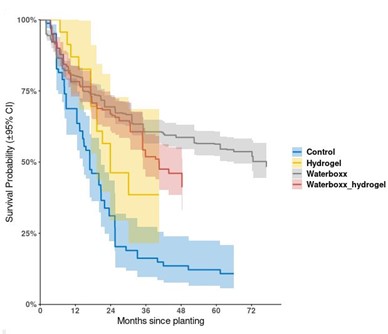
Representative graph of the survival percentage according to the different water-saving technologies. Source: RestoR GV2050. Capture date: October 2022.
Do you want to know more about our project in South Plaza?
- Charles Darwin Foundation - Galapagos Verde 2050: Restoring ecological integrity to South Plaza (darwinfoundation.org)
- Charles Darwin Foundation - Galapagos Verde 2050 continues to contribute to the ecological restoration of South Plaza (darwinfoundation.org)
- Action-Plan-for-the-Ecological-Restoration-of-Baltra-and-Plaza-South-Islands.pdf (researchgate.net)
You can also find our news on social networks:
- Expedition to South Plazaà https://www.facebook.com/charlesdarwinfoundation/posts/3294416007278202
- History of South Plazaà https://www.facebook.com/charlesdarwinfoundation/posts/341738479498132
- South Plaza Tripà https://www.facebook.com/charlesdarwinfoundation/posts/4087000708019724
You can download more information from some of our publications
- BOOK GV2050: The Galapagos Verde 2050 Project (Volume 1)
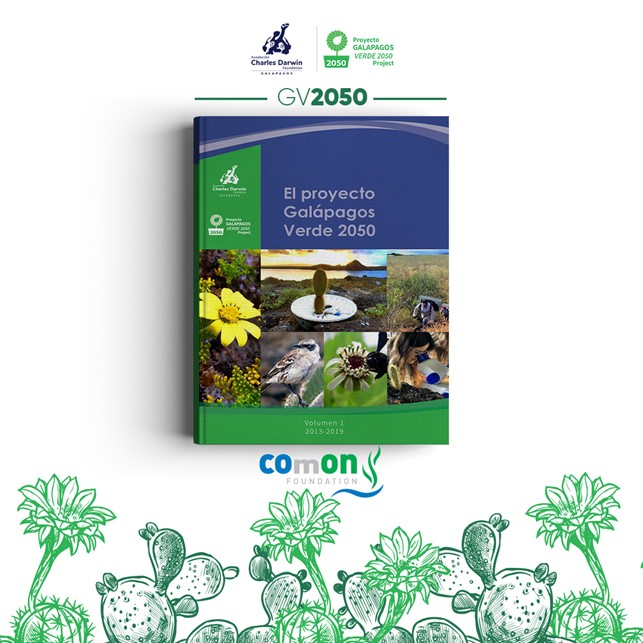
Examples of scientific articles:
- (PDF) Effectiveness of water-saving technologies during early stages of restoration of endemic g cacti in the Galápagos Islands, Ecuador (researchgate.net)
- (PDF) Cost‐effectiveness of water‐saving technologies for restoration of tropical dry forest: A case study from the Galapagos Islands, Ecuador (researchgate.net)
REFERENces
Christian, KA, & Tracy, CR (1980). An update on the status of Isla Santa Fe since the eradication of the feral goats. Galapagos News , 31 , 16–17.
deVries, T. (1989). Conservation, Status and Ecological Importance of the Galapagos Hawk Buteo galapagoensis. Raptors in the Modern World , 327–330.
Institute of Ecology. (2021). Ecosystem Engineers . Government of Mexico. https://www.inecol.mx/inecol/index.php/es/2017-06-26-16-35-48/17-ciencia-hoy/1462-engineers-ecosistemicos
Jaramillo, P., Tapia, W., & Gibbs, J. (2017). Action Plan for the Ecological Restoration of Baltra and South Plaza Islands. 2 , 1–29.
Jaramillo, P., Tapia, W., Negoita, L., Plunkett, E., Guerrero, M., Mayorga, P., & Gibbs, JP (2020). The Green Galapagos 2050 Project .
Sulloway, FJ, & Noonan, KM (2015). Opuntia Cactus Loss in the Galapagos Islands, 1957-2014 . Puerto Ayora .
Tapia, PI, Negoita, L., Gibbs, JP, & Jaramillo, P. (2019). Effectiveness of water-saving technologies during early stages of restoration of endemic Opuntia cacti in the Galapagos Islands, Ecuador. PeerJ , 2019 (12). https://doi.org/10.7717/peerj.8156
Inter-institutional collaborations
Galapagos National Park Directorate (GNPD), Galapagos Conservancy, Agency for the regulation and control of biosecurity and quarantine for Galapagos (ABG)
Our main donor
COmON Fundación

 Donors:
Donors:

Partners:




